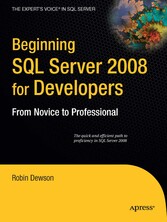Search and Find
Service
Contents at a Glance
5
Contents
6
About the Author
15
About the Technical Reviewer
16
Acknowledgments
17
Introduction
18
Who This Book Is For
18
How This Book Is Structured
18
Prerequisites
18
Downloading the Code
19
Contacting the Author
19
SQL Server 2008 Overview and Installation
20
Why SQL Server 2008?
21
Evolution of SQL Server
22
Hardware Requirements
23
The Example
24
Installation
24
Security
36
Summary
42
SQL Server Management Studio
43
A Quick Overview of SSMS
43
Examining SSMS’s Options
51
Query Editor
66
Summary
68
Database Design and Creation
69
Defining a Database
70
Prebuilt Databases Within SQL Server
71
Choosing the Database System Type
74
Gathering the Data
75
Determining the Information to Store in the Database
77
External and Ignored Information
79
Building Relationships
80
Normalization
85
Creating the Sample Database
89
Summary
107
Security and Compliance
108
Logins
108
Server Logins and Database Users
118
Roles
118
Schemas
124
Before You Can Proceed with Your Solution
126
Declarative Management Framework
130
Summary
134
Defining Tables
136
What Is a Table?
136
SQL Server Data Types
137
Columns Are More Than Simple Data Repositories
143
Image and Large Text Storage in SQL Server
145
Creating a Table in SQL Server Management Studio
145
Creating a Table Through the Query Editor
151
Creating a Table: Using a Template
153
Creating and Altering a Template
156
The ALTER TABLE Statement
157
Defining the Remaining Tables
158
Setting a Primary Key
159
Creating a Relationship
160
Building a Relationship via T-SQL
165
Summary
167
Creating Indexes and Database Diagramming
168
What Is an Index?
168
Determining What Makes a Good Index
171
Determining What Makes a Bad Index
173
Reviewing Your Indexes for Performance
174
Creating an Index
175
Dropping an Index
187
Altering an Index in Query Editor
188
When an Index Does Not Exist
189
Diagramming the Database
189
Summary
196
Database Backups, Recovery, and Maintenance
197
Transaction Logs
198
Backup Strategies
199
When Problems May Occur
201
Taking a Database Offline
201
Backing Up the Data
203
Restoring a Database
216
Detaching and Attaching a Database
223
Producing SQL Script for the Database
231
Maintaining Your Database
236
Creating a Database Maintenance Plan
237
Setting Up Database Mail
250
Modifying a Maintenance Plan
259
Summary
263
Working with the Data
264
The T- SQL INSERT Command Syntax
264
INSERT SQL Command
265
DBCC CHECKIDENT
272
Column Constraints
273
Inserting Several Records at Once
278
Retrieving Data
279
Using SQL Server Management Studio to Retrieve Data
280
The SELECT Statement
281
Naming the Columns
283
The First Searches
283
Varying the Output Display
285
Limiting the Search: the Use of WHERE
287
String Functions
293
Order! Order!
294
The LIKE Operator
296
Creating Data: SELECT INTO
298
Who Can Add, Delete, and Select Data
299
Updating Data
304
Transactions
309
Deleting Data
315
Truncating a Table
318
Dropping a Table
319
Summary
319
Building a View
321
Why a View?
321
Using Views for Security
322
Encrypting View Definitions
323
Creating a View: SQL Server Management Studio
323
Creating a View Using a View
329
CREATE VIEW Syntax
335
Creating a View: a Query Editor Pane
336
Creating a View: SCHEMABINDING
337
Indexing a View
339
Summary
341
Stored Procedures and Functions
343
What Is a Stored Procedure?
344
CREATE PROCEDURE Syntax
344
Returning a Set of Records
346
Creating a Stored Procedure: Management Studio
347
Different Methods of Executing
351
Using RETURN
351
Controlling the Flow
355
Bringing It All Together
361
User- Defined Functions
363
Summary
367
T-SQL Essentials
368
Using More Than One Table
368
Variables
373
Temporary Tables
375
Aggregations
377
Grouping Data
380
HAVING
382
Distinct Values
383
Functions
383
RAISERROR
397
Error Handling
400
@@ ERROR
401
TRY. . . CATCH
402
Summary
406
Advanced T-SQL
407
Subqueries
407
The APPLY Operator
411
Common Table Expressions
414
Pivoting Data
417
Ranking Functions
419
PowerShell Within SQL Server
424
Summary
428
Triggers
429
What Is a Trigger?
429
The DML Trigger
430
CREATE TRIGGER Syntax for DML Triggers
431
Why Not Use a Constraint?
432
Deleted and Inserted Logical Tables
433
Creating a DML FOR Trigger
433
Checking Specific Columns
437
DDL Triggers
444
Summary
450
SQL Server 2008 Reporting Services
451
Reporting Services Architecture
451
Configuring Reporting Services
453
Building Your First Report Using Report Designer
460
Summary
469
Index
470
All prices incl. VAT













